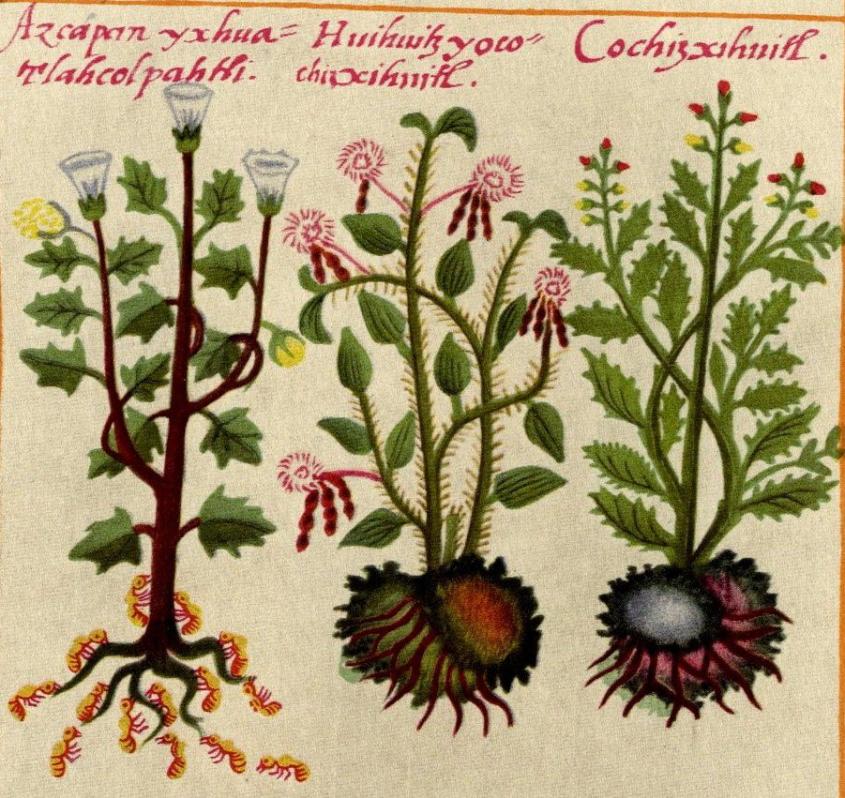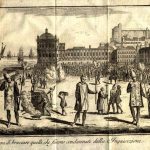When Cassiano dal Pozzo, the Pope’s personal assistant, returned to the Vatican from Spain in 1626, he brought with him a Mexican manuscript on natural history, the Libellus de medicinalibus Indorum herbis. The “herbal” was a marvelous Mexican manuscript containing illustrations of more than 180 plants. Commonly known as Codice de la Cruz-Badiano, it is considered the first illustrated survey of Mexican nature produced in the New World.
In 1552, the son of the Viceroy, Francisco de Mendoza, sent the Latin manuscript to Spain, where it probably remained until the early seventeeth century, when it came into the possession of Diego de Cortavila y Sanabria. It next appeared in the library of the Italian Cardinal Francesco Barberini, where it remained until 1902, when the Barberini library became part of the Vatican Library. The manuscript was rediscovered in 1929 by Charles Upson Clark and finally, in 1991, Pope John Paul II returned the Libellus to Mexico, where it is now in the library of the National Institute of Anthropology and History in Mexico City.
 The herbal is organized in chapters associated with parts of the body, starting with afflictions of the head, eyes, ears, nose, teeth, and cheeks; it then goes to the chest and stomach, and continues with the knees and feet; it ends with “falling sickness or comitial sickness” and remedies for “fear or faint-heartedness, mental stupor, for one afflicted by a whirlwind or a bad wind, … and for a traveler crossing a river or lake.” The diseases treated in the herbals are named in Latin in accordance with the tradition of medieval and early modern European herbals. However, the names of the plants are all written in Náhuatl, the indigenous Aztec language.
The herbal is organized in chapters associated with parts of the body, starting with afflictions of the head, eyes, ears, nose, teeth, and cheeks; it then goes to the chest and stomach, and continues with the knees and feet; it ends with “falling sickness or comitial sickness” and remedies for “fear or faint-heartedness, mental stupor, for one afflicted by a whirlwind or a bad wind, … and for a traveler crossing a river or lake.” The diseases treated in the herbals are named in Latin in accordance with the tradition of medieval and early modern European herbals. However, the names of the plants are all written in Náhuatl, the indigenous Aztec language.
The manuscript, produced by a Nahua physician, Martín de la Cruz, and translated into Latin by Juan Badiano, was a gift for the king that sought to demonstrate the worthiness of educating the Nahua nobility in the Colegio de Santa Cruz de Tlatelolco. At first glance, this marvelous codex resembles a typical medieval herbal. A closer look, however, reveals a fascinating blend of European and Aztec cultures. The codice can be viewed as a form of expression of the Nahua in a context of increased European influence and as a manner of dealing with a changing reality.
 Visual culture is a powerful means by which different societies depict reality and convey meanings. The images contained in this sixteenth-century manuscript pose great challenges to scholars willing to consider visual evidence as core material of historical analysis. What was the purpose of the pictographic material as utilized by the authors of the codice? Can we determine which patterns and conventions are purely Aztec or European? Is there such thing as a pure visual tradition? Does it make sense to study colonial sources under the assumption of cultural contamination? Aside from questions of cultural purity or contamination, perhaps a more interesting question to be asked is whether the purpose of these illustrations is primarily informational or aesthetic.
Visual culture is a powerful means by which different societies depict reality and convey meanings. The images contained in this sixteenth-century manuscript pose great challenges to scholars willing to consider visual evidence as core material of historical analysis. What was the purpose of the pictographic material as utilized by the authors of the codice? Can we determine which patterns and conventions are purely Aztec or European? Is there such thing as a pure visual tradition? Does it make sense to study colonial sources under the assumption of cultural contamination? Aside from questions of cultural purity or contamination, perhaps a more interesting question to be asked is whether the purpose of these illustrations is primarily informational or aesthetic.
As a gift to the king, aesthetics certainly played an important role in the purpose of the illustrations. The beauty of the pictures is undeniable, and the extensive use of colors to depict nature surpasses other depictions of nature of the time. Although scholars have regarded the manuscript as a European source due to its resemblance to late medieval and early modern herbals, the codice contains pictographic elements of the Nahua tradition such as the glyphs, which convey both descriptive elements and the ecology of the plants. Take for example the Nahua glyph for stone –tetl– which works as a ideogram to point to the rocky soil in which the plant grows in the illustration above. The ants visible among the roots in the illustration below also indicate the environment in which this plant grows. The ants, however, are not associated with any Náhuatl glyph but it was common in European herbals to include associated parasites in such illustrations.
 The Codice de la Cruz-Badiano is an example of the encounter of between writing systems, and thus of systems of knowledge, with multiple swings from the pictographic-glyphic tradition to the alphabetical. The illustrations are by no means subordinated to the writing. Visual evidence and linguistic analysis of Náhuatl offer ways of approaching the complexities of cultural forms and to provide information about natural history that was not present in the Latin texts.
The Codice de la Cruz-Badiano is an example of the encounter of between writing systems, and thus of systems of knowledge, with multiple swings from the pictographic-glyphic tradition to the alphabetical. The illustrations are by no means subordinated to the writing. Visual evidence and linguistic analysis of Náhuatl offer ways of approaching the complexities of cultural forms and to provide information about natural history that was not present in the Latin texts.
This article is excerpted from the forthcoming publication:
Maria José Afanador Llach. “Nombrar y representar. Escritura y naturaleza en el Códice De la Cruz-Badiano, 1552.” In Fronteras de la Historia, vol. 16-1, Instituto Colombiano de Antropología e Historia, Bogotá, June 2011.
The codice is available in facsimile: De la Cruz, Martín, The Badianus manuscript (Codex Barberini, Latin 241) Vatican Library; an Aztec herbal of 1552. Ed. Emily Walcott Emmart. Baltimore: The Johns Hopkins Press, 1940.
For more on the codice see:
Debra Hassig, “Transplanted Medicine: Colonial Mexican Herbals of the Sixteenth Century.” Anthropology and Aesthetics 17-18, Spring/Autumn (1989).



